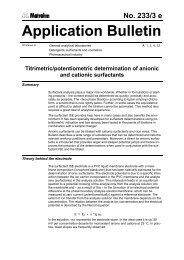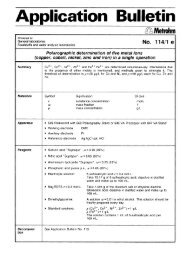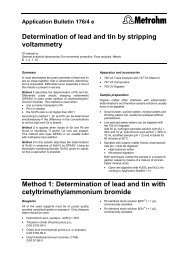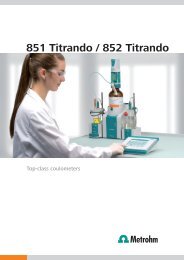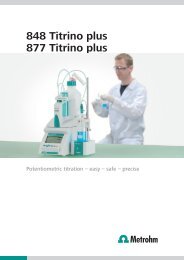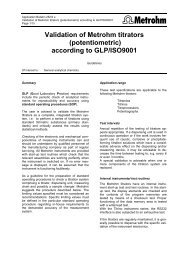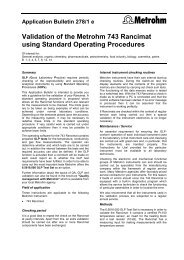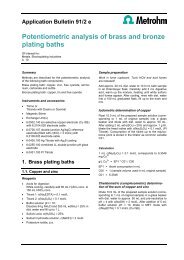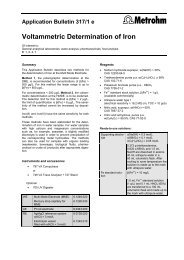Titer determination in potentiometry - Metrohm
Titer determination in potentiometry - Metrohm
Titer determination in potentiometry - Metrohm
You also want an ePaper? Increase the reach of your titles
YUMPU automatically turns print PDFs into web optimized ePapers that Google loves.
Application Bullet<strong>in</strong> 206/4 e<strong>Titer</strong> <strong>determ<strong>in</strong>ation</strong> <strong>in</strong> <strong>potentiometry</strong>Page 3/4Table. 2:Precipitation titrations (argentometry)Redox titrations (cerimetry, iodometry, permanganometry, ferrometry, Karl Fischer titration)Titrant Titrimetric standard Electrode RemarksSilver nitrate AgNO 3Lanthanum nitrateLa(NO 3 ) 3Cerium(IV) <strong>in</strong> H 2 SO 4 orHClO 4Sodium chloride NaCl(110 °C)Sodium fluoride NaF(110 °C)Arsenic trioxide As 2 O 3(105 °C)Iod<strong>in</strong>e solution KI 3 Arsenic trioxide As 2 O 3(105 °C)Potassium permanganateKMnO 4Sodium thiosulfateNa 2 S 2 O 3Iron(II) solution(NH 4 ) 2 Fe(SO 4 ) 2Sodium oxalateNa 2 C 2 O 4(105 °C)Potassium hydrogendiiodate KH(IO 3 ) 2(100 °C)Potassium dichromateK 2 Cr 2 O 7(105 °C)6.0450.100 comb<strong>in</strong>edAg r<strong>in</strong>g electrode (referenceelectrolyte: KNO 3saturated) or6.0430.100 Ag Titrode6.0502.150 fluoride ISE;6.0726.107 referenceelectrode (filled withc(KCl) = 3 mol/L)6.0451.100 comb<strong>in</strong>ed Ptr<strong>in</strong>g electrode or6.0431.100 Pt Titrode6.0451.100 comb<strong>in</strong>ed Ptr<strong>in</strong>g electrode or6.0431.100 Pt Titrode6.0451.100 comb<strong>in</strong>ed Ptr<strong>in</strong>g electrode or6.0452.100 comb<strong>in</strong>edAu r<strong>in</strong>g electrode6.0451.100 comb<strong>in</strong>ed Ptr<strong>in</strong>g electrode or6.0431.100 Pt Titrode6.0452.100 comb<strong>in</strong>edAu r<strong>in</strong>g electrodeSodium nitrite NaNO 2 Sulfanilic acid 6.0452.100 comb<strong>in</strong>edAu r<strong>in</strong>g electrodeKarl Fischer reagentSodium tartrate dihydrateC 4 H 4 Na 2 O 6 x2 H 2 O orwater standards <strong>in</strong>ampoules (Riedel-deHaën)6.0338.100 polarizeddouble Pt electrodeDissolve NaCl <strong>in</strong> 40 mL water, thenadd 2 mL c(HNO 3 ) = 2 mol/L and possibly2 mL 0.2% polyv<strong>in</strong>yl alcohol solution.(Dissolve polyv<strong>in</strong>yl alcohol (Merck No.114266) <strong>in</strong> warm water.)Dissolve NaF <strong>in</strong> 50 mL water, add10 mL acetate buffer pH = 6.0 andtitrate slowly (see also <strong>Metrohm</strong> ABNo. 82).Dissolve As 2 O 3 <strong>in</strong> 10 mL c(NaOH) =1 mol/L, then add 6 mL c(H 2 SO 4 ) =1 mol/L and 2 g NaHCO 3 (see also<strong>Metrohm</strong> AB No. 52).Dissolve As 2 O 3 <strong>in</strong> 10 mL c(NaOH) =1 mol/L, then add 6 mL c(H 2 SO 4 ) =1 mol/L and 2 g NaHCO 3 .Dissolve Na 2 C 2 O 4 <strong>in</strong> 40 mL water, thenadd 5 mL concentrated H 2 SO 4 and 1 gMnSO 4 .Stock solution: Dissolve KH(IO 3 ) 2 <strong>in</strong>water and make up to 100 mL; use10 mL of this solution, dilute with40 mL water, then add 1 g KI and 4 mLc(HCl) = 1 mol/L.Dissolve K 2 Cr 2 O 7 <strong>in</strong> 40 mL water, thenadd 3 mL concentrated H 2 SO 4 .Dissolve sulfanilic acid <strong>in</strong> 50 mL water,add 30 mL w(HBr) = 20% and titrateimmediately us<strong>in</strong>g the MET mode(0.10 mL, 25 s).Fill methanol or KF solvent <strong>in</strong>to thetitration vessel and condition. As soonas a steady drift is atta<strong>in</strong>ed, add thestandard and titrate with the KF reagent.The titer is specified <strong>in</strong> mg H 2 O / mLKF reagent (documentation availablefrom Riedel-de Haën or Merck).The <strong>in</strong>dicated electrodes are meant as a suggestion. It is often also possible to use other electrodes or electrodesystems.





